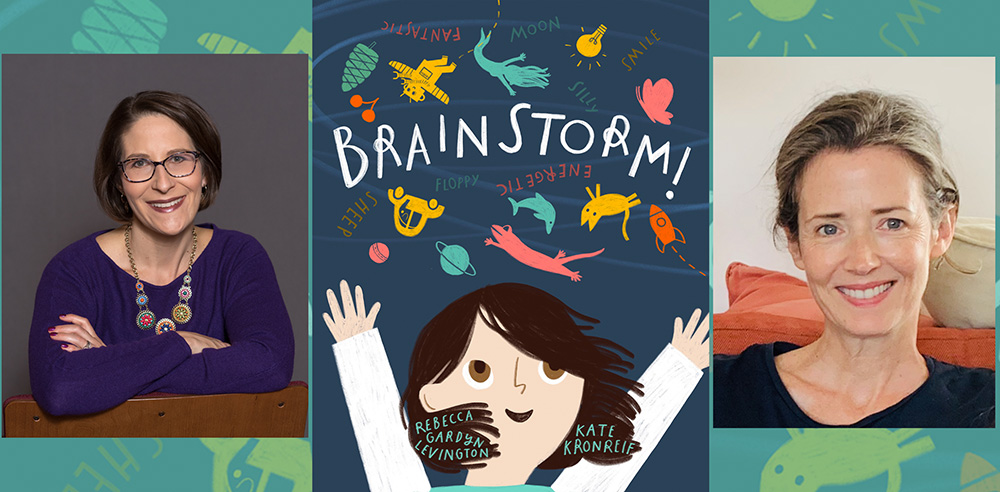
Rebecca Gardyn Levington is a children’s book author, poet, and journalist. Her debut picture book BRAINSTORM! (Sleeping Bear Press, 2022, with illustrator Kate Konreif) hits bookshelves August 3rd, 2022 – you can pre-order a personalized, signed copy from her local indie bookstore, Words in Maplewood, NJ. She has four more rhyming picture books being published in the next two years, including WHATEVER COMES TOMORROW (Barefoot Books, 2023) and I WILL ALWAYS BE… (HarperCollins, 2024). She lives in New Jersey with her husband and two boys. Find out more about Rebecca at www.RebeccaGardynLevington.com and follow her on Twitter at @WriterRebeccaGL.
Kate Kronreif is a British illustrator and graphic designer who lives with her family in Vienna, Austria. Brainstorm! is her third picture book. You can find out more about Kate at KateKronreif.com and on Instagram at @kate.kronreif.
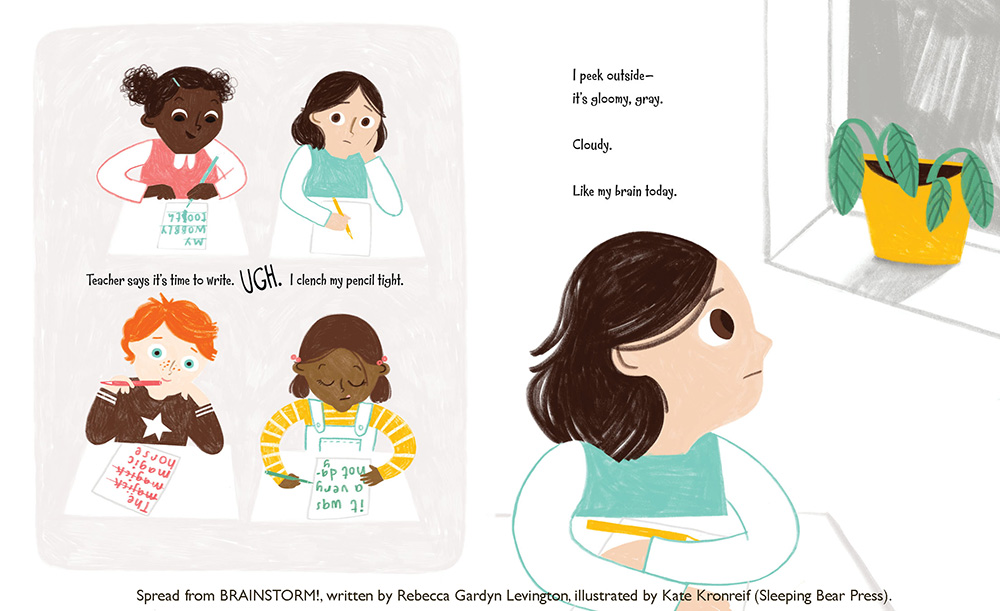
Synopsis of BRAINSTORM! (Sleeping Bear Press):
BRAINSTORM! is a rhyming concept picture book that begins with a little girl sitting in a classroom, frustrated because she can’t think of anything to write about. As she stares at the storm brewing outside – kerplink! – a tiny thought falls from the sky. The girl gradually finds herself engulfed in a whirlwind of words, pictures, and ideas swirling all around her, eventually becoming caught up in a happy downpour of her own creativity.
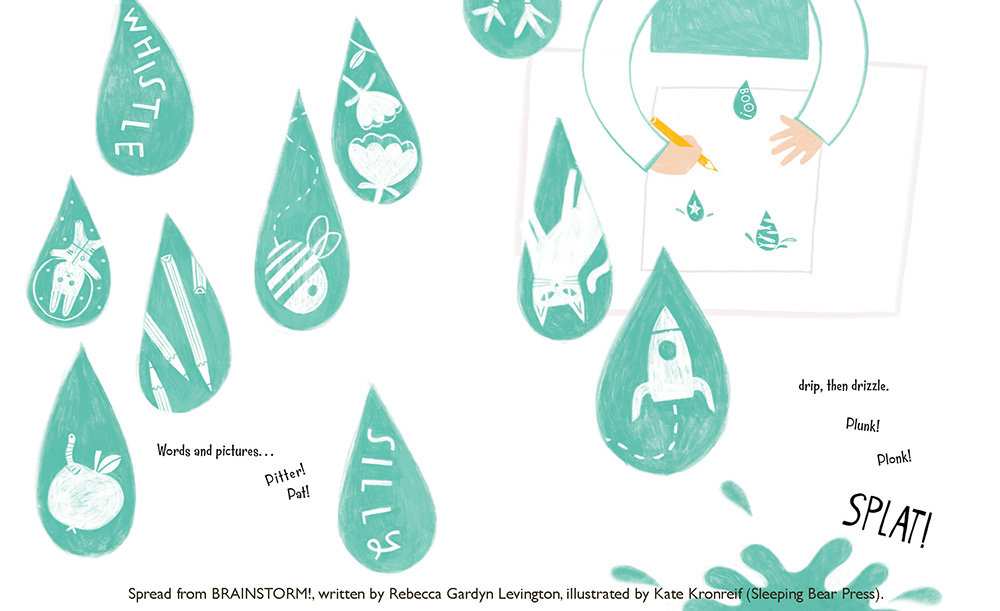
BRAINSTORM! is targeted to children in grades K-3, who are beginning to learn how to shape and sharpen their idea-generation and storytelling skills. The back matter includes writing prompts (“Cloudy With A Chance of Ideas!”) as well as a glossary (“A Tornado of Terminology”) that parents and educators can use to encourage kids to have fun playing with their ideas.
Q for Rebecca: What was your journey to publication for this book?
Rebecca: It was a dark and stormy night… (no, seriously it was!) and I was having a terrible bout of writer’s block when — BAM! — I looked out my window at the storm brewing outside and wondered: Hmmm….what if IDEAS rained down from the sky… you know, like a…rain storm… NO, wait!…like a…. BRAINSTORM!
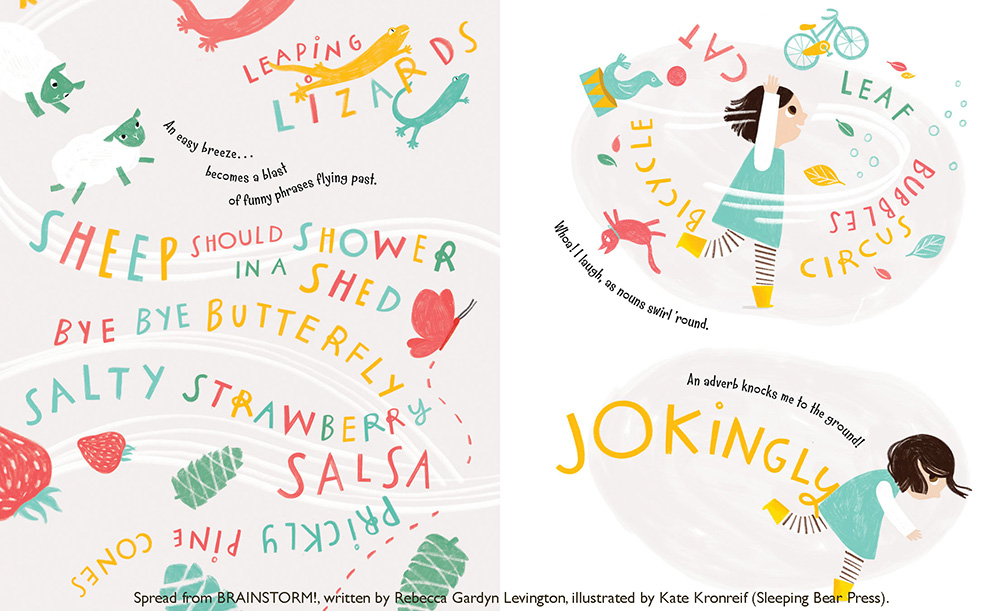
I began writing what I first thought would remain a short poem, but as I tinkered, I begin thinking that maybe this could be a picture book. After revising and polishing with the help of my CPs, I sent it out to a bunch of agents and editors (I was unagented at the time). And while I had some nice feedback, there were no bites. Then, in late 2019, my amazing #PBChat mentor and rhyme writer extraordinaire, Lori Degman, introduced me to editor Sarah Rockett at Sleeping Bear Press, who kindly offered to take a look a manuscript from me. I sent her one (not Brainstorm!) and although she passed on it, she said she liked my writing and invited me to send more. So, I sent two more (also not Brainstorm!), which she also kindly passed on. Then I sent her fourth story (yup, Brainstorm!) and Sarah emailed me to say that she and her team loved it and that they wanted to acquire it for their 2022 list! YAHOO!!!
(FYI, this is a VERY condensed and Hollywood-esque version of what actually happened. Indeed, there was a LOT of lag time between all these steps. For context, the total time between me sending Sarah manuscript #1 and the time I received the contract for Brainstorm! was a full YEAR).
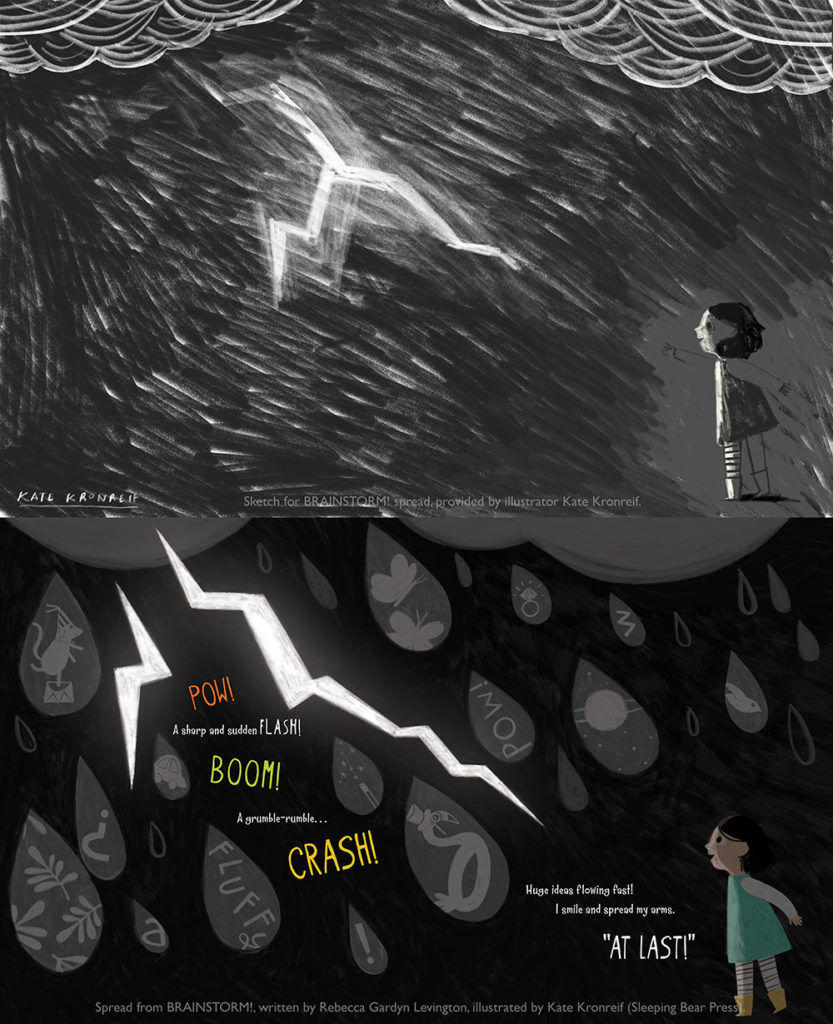
Q for Kate: How did you become involved with illustrating Brainstorm! and what was your illustration process?
Kate: My lovely agent at Bright passed me the manuscript for Brainstorm; I thought it was great fun and couldn’t wait to get started on it.
I began with character development, which is always my favourite part; I did lots of sketches of a few different characters – boys and girls – before the publisher settled on the girl with dark hair. The others ended up in the book too, as our heroine’s classmates.
I did all my initial sketches with pencil and paper, then imported them into my iPad. From that point on, I did everything digitally, in Procreate; I played around with the sketches, refining them a bit until I was happy with them, and then made the final artwork.
(Note from Debbie: Kate’s art director was Felicia Macheske at Sleeping Bear Press)
Q for Rebecca: What advice do you have for picture book writers about using rhyme?
Rebecca: So, here’s the thing: writing in rhyme LOOKS super easy. But, oh man, IT IS HARD. And if you don’t know what you’re doing, it shows (and, believe me, it’s NOT a good look!).
I remember when I was first starting out, I was listening to one of Julie Hedlund’s 12×12 webinars and she said something like: “If you don’t know what the terms ‘scansion,’ ‘meter,’ ‘stressed beats,’ ‘iamb,’ ‘trochee,’ ‘anapest,’ and ‘dactyl,’ mean or how they apply to your writing, you should NOT be writing in rhyme.”
Well, I didn’t have a clue what she was talking about, but I LOVED writing in rhyme, so I was determined to educate myself. I enrolled in rhyme goddess Renee LaTulippe’s INCREDIBLE Lyrical Language Lab course, where she teaches you ALL the terms listed above and SO much more. I cannot recommend her class enough (and I promise she does not pay me – although she could and I would be totally o.k with it).
So, my advice is that if you love rhyme and want to sell books in rhyme, take the time to learn how to do it well. Don’t just assume you know what you’re doing because you “just hear it in your head.” You may have a great ear for it, and that’s wonderful, but remember, you will not be there to read your book to every person who picks it up. The goal, therefore, is to craft a book that can be read by ANYONE (with any accent, in any part of the world) and they will not stumble or question “how” they should read it. And the only way to do this is to understand how to build a story with PERFECT meter (i.e. how to create sentences with stressed beats that are perfectly placed) and how to choose rhymes and add lyrical devises that will make sure those sentences are read with ease and fluidity. This is why people say it is difficult to write rhyme well. There is SO much more that goes into it than merely rhyming “cat” with “hat.”
All that said, if you do put the time in to learn the craft, you CAN sell books. All that mumbo-jumbo about “all agents/editors not liking rhyme” is hog-wash. I’ve sold five rhyming books in the last two years. There are PLENTY of agents/editors who do like rhyme – but it MUST be done well.
Q. for Kate: What advice do you have for young illustrators?
My advice for young illustrators would be to just keep drawing, as much as possible. Keep looking and keep drawing. And have fun and try out new ways of making work – paint, make collages, maybe little films – experiment, don’t be precious and don’t worry if not everything’s perfect, just keep doing it!
Q for Rebecca. What advice do you have for young writers?
There is so much I could say, but I think the biggest thing is to find the type of writing that works for YOU. Write the books that you are happy writing and don’t think too hard about following “rules.”
When I started, I felt like I “had” to write books with interesting or quirky MCs or that had narrative arcs where the MC tried three times before accomplishing his/her goal, etc. I thought I “shouldn’t” write in rhyme because “no one likes rhyme.” But every time I tried to write a story that conformed to the “rules,” they always fell flat and I often felt disconnected from my work. It wasn’t until I began tinkering more with children’s poetry that I realized that the books I loved reading the most were really more like long poems. I began studying these “concept” or “poem-picture books” and realized that writing these types of manuscripts felt much more natural to me. Once I started thinking of my “stories” as extended poetry and stopped focusing so much on characters and story arcs, my writing began to flow more easily and I began to sell books.
In fact, I often tell people that I no longer write picture book “drafts” but instead I write “poems with possibility.” Of the five books I’ve sold so far, three of them started as short poems.
So, I will wrap up my advice with my very favorite quote: “Do what you love; love what you do.” I have no idea who said it (but whoever it was knew their stuff!) I encourage all writers to write what brings them joy. The rest, I promise, will follow.
Debbie, thank you so much for having me on your blog! I’ve had so much fun sharing my journey with you!
For more insights from children’s book creators, see my Interviews Archive.

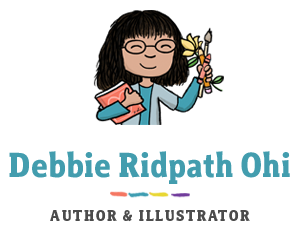
Great interview for us rhymers! Thank you!